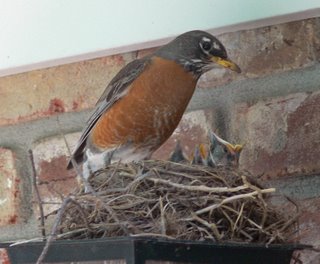
 I like watching and identifying big birds because I can see their characteristics easily. Those DLBs (Darn Little Birds) are another story though. At Muscatatuck NWR on Memorial Day, a small bird landed in a tree within view of my camera, so I took some pictures of it. I must confess, I was concentrating more on focusing the camera than observing the bird closely. After all, you can always go back again and look at the picture if you aren't sure what the bird is, right? There was a nest nearby, in the eaves of the latrine building. Both bird and nest were close to a lake and the deciduous woods of the Reserve.
As I researched this bird, I'm not sure if it is an Eastern Phoebe or an Eastern Woods Pee-wee. In fact, I'm not sure if these two photos are really the same bird or not, due to the light differences, although both were taken within 3 feet of each other. The little top knot on the head is about the same and both seem have a wing bar. However, the bill on one looks dark, while the bill on the other looks yellow on the bottom. My research says the dark billed Phoebe has weaker wing bars and tends to wag its tail, but I didn't notice the bird's behavior as I tried to focus on it for a good shot.
I like watching and identifying big birds because I can see their characteristics easily. Those DLBs (Darn Little Birds) are another story though. At Muscatatuck NWR on Memorial Day, a small bird landed in a tree within view of my camera, so I took some pictures of it. I must confess, I was concentrating more on focusing the camera than observing the bird closely. After all, you can always go back again and look at the picture if you aren't sure what the bird is, right? There was a nest nearby, in the eaves of the latrine building. Both bird and nest were close to a lake and the deciduous woods of the Reserve.
As I researched this bird, I'm not sure if it is an Eastern Phoebe or an Eastern Woods Pee-wee. In fact, I'm not sure if these two photos are really the same bird or not, due to the light differences, although both were taken within 3 feet of each other. The little top knot on the head is about the same and both seem have a wing bar. However, the bill on one looks dark, while the bill on the other looks yellow on the bottom. My research says the dark billed Phoebe has weaker wing bars and tends to wag its tail, but I didn't notice the bird's behavior as I tried to focus on it for a good shot.
 One source says the Phoebe often nests in or around human habitations, building mud and grass nests under the eaves of buildings. The Pee-wee builds a nest on a horizontal limb well out from a trunk in a living tree. If it had sung, I could have recognized the song, but I didn't hear anything that day. Therefore, if the nest belongs to the bird I saw, I'd guess it's the Phoebe.
One source says the Phoebe often nests in or around human habitations, building mud and grass nests under the eaves of buildings. The Pee-wee builds a nest on a horizontal limb well out from a trunk in a living tree. If it had sung, I could have recognized the song, but I didn't hear anything that day. Therefore, if the nest belongs to the bird I saw, I'd guess it's the Phoebe.
Second guessing on a bird's identity can drive you crazy. However, it is also dangerous to go with the first bird you see in the book that looks kind of like the one you saw. One time I had to ask a local expert about a picture, and he confidently said it was a mocking bird. That's what I thought the first time, in fact, but the longer I worked with it, the less confident I was. Will I ever have that confidence level? There are so many pieces to look at - color, lighting, stripes, legs, song. How can I get those birds to pose nicely and sing for me at the same time? Settle down there, girl, don't get all hyper. Remember, you are doing this for the fun of it, right? Don't get so wrapped up that you forget that part. This isn't a contest, and no one will give you a bad grade if you get something wrong. Every time you try to make a tough identification, you learn something else, and that alone is worthwhile. Take a deep breath and move on to the next bird.







